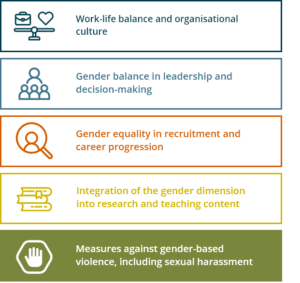Nehem is an important service provider in the field of Diversity, Equity and Inclusion (DEI). Our DEI experts are committed to contribute to SDG 5, and have the knowledge and tools to support organisations in the creation of a gender equal work environment where talent can thrive.
Gender equality is a broad and multi-faceted concept. The European Commission recommends a division into five thematic areas for gender equality in research & innovation. In a series of five articles, we will introduce you to these thematic areas, which we like to call Key Areas of Intervention (KAIs). This article will focus on KAI 5: ‘Measures against gender-based violence, including sexual harassment’.

The #MeToo movement changed the world in 2017, resulting in an increased awareness around the issue of gender-based violence and sexual harassment, allowing victims to come forward and pushing organisations to seriously address the issue. The movement made it clear that sexual harassment is not an individual issue but a systemic one, requiring protections in the form of laws and regulations to help prevent it from happening and to put better structures in place to create accountability.
Despite this increased awareness, the issue remains prevalent. Although data on violence and harassment remain sporadic and scarce, a global survey in 2021 found that 743 million people had experienced violence and harassment at work – including physical, psychological or sexual – over their working life (International Labour Organization, 2021). Young women are particularly at risk, being twice as likely as young men to have experienced sexual violence and harassment. Recently, a large UK study showed that three in five (58%) women – and almost two- thirds (62%) of women aged between 25 and 34 – said they have experienced sexual harassment, bullying or verbal abuse at work (TUC, 2023). Most victims do not report it out of fear of not being believed, or damaging their working relationships and career prospects. Moreover, comparability of data is complex because different concepts, definitions and methods are used. However, these statistics do provide an account of the prevalence of violence and harassment in the workplace.
Gender-based violence can be defined as “violence directed at persons because of their sex or gender, or affecting persons of a particular sex or gender disproportionately” (ILO, 2019). Sexual harassment is one of the most common forms of gender-based violence that is particularly found in the workplace. The European Parliament defines sexual harassment as “any form of unwanted verbal, non-verbal or physical conduct of a sexual nature, with the purpose or effect of violating the dignity of a person” (2022). These forms of violence and harassment create an unsafe working environment, as it can undermine a person’s sense of competence at work, compromising their potential and the potential of the organisation. Besides the more overt types of violence, gender-based violence also includes intimidation, discrimination, bullying and microaggressions. Examples of microaggressions in the workplace are:
- Comments about a person’s appearance or mannerisms;
- Assumptions of inferiority, g. lower expectations for female co-workers;
- Inappropriate jokes of a sexual nature.
The prevalence of gender-based violence has a strong correlation to a male-dominated work environment, with dominant masculine norms often leading to gendered hierarchical relations and an institutional culture that is hard to change. Engaging men in the prevention of gender-based violence is therefore crucial. Effective measures are needed in order to successfully combat gender- based violence and harassment, such as providing information, transparency and reliability in the workplace – creating a safe environment where people feel encouraged to speak up when witnessing or experiencing misconduct. Examples of effective measures are:
- Develop a complaint procedure including a confidential counsellor;
- Create an anti-harassment policy, consent policy or whistleblowing policy;
- Facilitate conversations to increase awareness;
- Introduce an Active Bystander training where employees learn what to do when you witness gender-based violence or harassment in the workplace.
International Labour Organization (2021). Expériences of violence and harassment at work: A global first survey. Geneva.
TUC (2023). New TUC poll: 2 in 3 young women have experienced sexual harassment, bullying or verbal abuse at work.
ILO (2019). Violence and harassment convention, 2019. No. 190.
European Parliament (2022). Report on sexual harassment in the EU and MeToo evaluation. Committee on women’s rights and gender equality.
Read more about Diversity, Equity and Inclusion
MDIEU-subsidie: allerlaatste aanvraagronde in 2024
Uw personeel gezond werkend zijn pensioen laten halen; dat wil toch elke werkgever? Toch lukt dat niet altijd, bijvoorbeeld door fysieke of psychische klachten van medewerkers. De MDIEU-subsidie helpt werkgevers om medewerkers ‘duurzaam inzetbaar’ te houden. Plannen...
De SLIM subsidie voor samenwerkingsverbanden opent in juni
Het doel van de SLIM-regeling is het vergroten van het aantal mkb’s dat een ‘Leven Lang Ontwikkelen’ van werknemers in de onderneming mogelijk maakt. Dit betekent dat er in de onderneming aandacht is voor de ontwikkeling van het bedrijf én van de medewerkers....
KIEM, focus op Impact
Praktijkgericht onderzoek is cruciaal voor de aanpak van de grote maatschappelijke vraagstukken van deze tijd. Het draagt door zijn aard – vraaggestuurd, transdisciplinair, cross-sectoraal en inclusief – bij aan nieuwe en bruikbare oplossingen. Het creëert daarmee...


